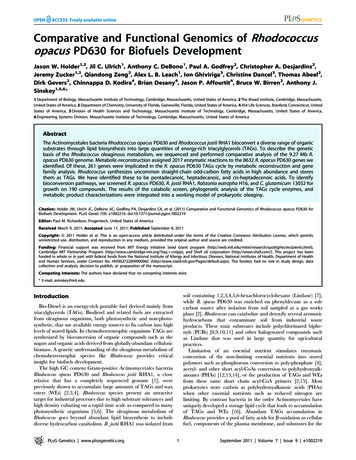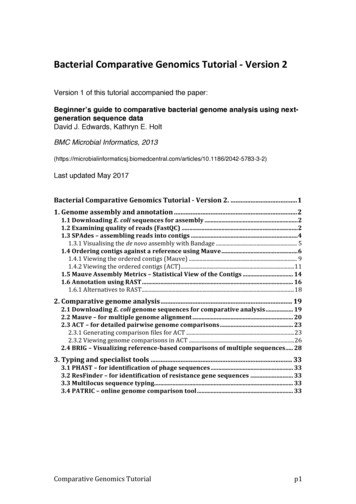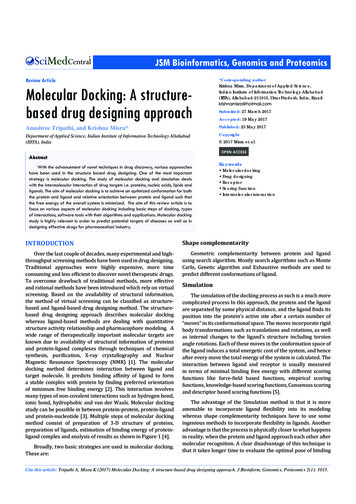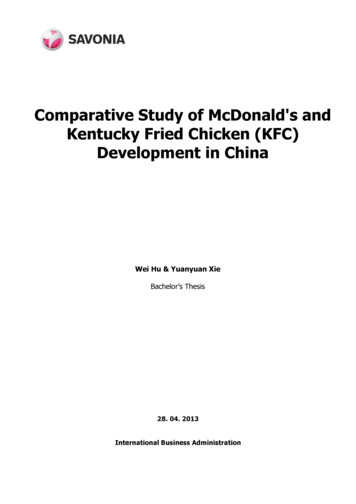
Transcription
Comparative and Functional Genomics of Rhodococcusopacus PD630 for Biofuels DevelopmentJason W. Holder1,2, Jil C. Ulrich1, Anthony C. DeBono1, Paul A. Godfrey2, Christopher A. Desjardins2,Jeremy Zucker1,2, Qiandong Zeng2, Alex L. B. Leach1, Ion Ghiviriga3, Christine Dancel3, Thomas Abeel2,Dirk Gevers2, Chinnappa D. Kodira4, Brian Desany4, Jason P. Affourtit4, Bruce W. Birren2, Anthony J.Sinskey1,5,6*1 Department of Biology, Massachusetts Institute of Technology, Cambridge, Massachusetts, United States of America, 2 The Broad Institute, Cambridge, Massachusetts,United States of America, 3 Department of Chemistry, University of Florida, Gainesville, Florida, United States of America, 4 454 Life Sciences, Branford, Connecticut, UnitedStates of America, 5 Division of Health Sciences and Technology, Massachusetts Institute of Technology, Cambridge, Massachusetts, United States of America,6 Engineering Systems Division, Massachusetts Institute of Technology, Cambridge, Massachusetts, United States of AmericaAbstractThe Actinomycetales bacteria Rhodococcus opacus PD630 and Rhodococcus jostii RHA1 bioconvert a diverse range of organicsubstrates through lipid biosynthesis into large quantities of energy-rich triacylglycerols (TAGs). To describe the geneticbasis of the Rhodococcus oleaginous metabolism, we sequenced and performed comparative analysis of the 9.27 Mb R.opacus PD630 genome. Metabolic-reconstruction assigned 2017 enzymatic reactions to the 8632 R. opacus PD630 genes weidentified. Of these, 261 genes were implicated in the R. opacus PD630 TAGs cycle by metabolic reconstruction and genefamily analysis. Rhodococcus synthesizes uncommon straight-chain odd-carbon fatty acids in high abundance and storesthem as TAGs. We have identified these to be pentadecanoic, heptadecanoic, and cis-heptadecenoic acids. To identifybioconversion pathways, we screened R. opacus PD630, R. jostii RHA1, Ralstonia eutropha H16, and C. glutamicum 13032 forgrowth on 190 compounds. The results of the catabolic screen, phylogenetic analysis of the TAGs cycle enzymes, andmetabolic product characterizations were integrated into a working model of prokaryotic oleaginy.Citation: Holder JW, Ulrich JC, DeBono AC, Godfrey PA, Desjardins CA, et al. (2011) Comparative and Functional Genomics of Rhodococcus opacus PD630 forBiofuels Development. PLoS Genet 7(9): e1002219. doi:10.1371/journal.pgen.1002219Editor: Paul M. Richardson, Progentech, United States of AmericaReceived March 9, 2011; Accepted June 17, 2011; Published September 8, 2011Copyright: ß 2011 Holder et al. This is an open-access article distributed under the terms of the Creative Commons Attribution License, which permitsunrestricted use, distribution, and reproduction in any medium, provided the original author and source are credited.Funding: Financial support was received from MIT Energy Initiative Seed Grant program pients.html),Cambridge MIT Partnership Program (http://www.cambridge-mit.org/?tag cmipp), and Shell oil corporation (http://www.shell.com/). This project has beenfunded in whole or in part with federal funds from the National Institute of Allergy and Infectious Diseases, National Institutes of Health, Department of Healthand Human Services, under Contract No. HHSN272200900006C (http://www.niaid.nih.gov/Pages/default.aspx). The funders had no role in study design, datacollection and analysis, decision to publish, or preparation of the manuscript.Competing Interests: The authors have declared that no competing interests exist.* E-mail: asinskey@mit.edusoil containing 1,2,3,4,5,6-hexachlorocyclohexane (Lindane) [7],while R. opacus PD630 was enriched on phenyldecane as a solecarbon source after isolation from soil sampled at a gas worksplant [2]. Rhodococcus can catabolize and detoxify several aromatichydrocarbons that contaminate soil from industrial wasteproducts. These toxic substrates include polychlorinated biphenyls (PCBs) [8,9,10,11] and other halogenated compounds suchas Lindane that was used in large quantity for agriculturalpractices.Limitation of an essential nutrient stimulates enzymaticconversion of the non-limiting essential nutrients into storedpolymers such as phosphorous conversion to poly-phosphate [4],acetyl- and other short acyl-CoAs conversion to polyhydroxyalkanoates (PHAs) [12,13,14], or the production of TAGs and WEsfrom these same short chain acyl-CoA primers [2,15]. Mostprokaryotes store carbon as polyhydroxyalkanoic acids (PHAs)when other essential nutrients such as reduced nitrogen arelimiting. By contrast bacteria in the order Actinomycetales haveuniquely developed a storage lipid cycle that leads to accumulationof TAGs and WEs [16]. Abundant TAGs accumulation inRhodococcus provides a pool of fatty acids for b-oxidation as cellularfuel, components of the plasma membrane, and substrates for theIntroductionBio-Diesel is an energy-rich portable fuel derived mainly fromtriacylglycerols (TAGs). Biodiesel and related fuels are extractedfrom oleaginous organisms, both photosynthetic and non-photosynthetic, that use available energy sources to fix carbon into highlevels of stored lipids. In chemoheterotrophic organisms TAGs aresynthesized by bioconversion of organic compounds such as thesugars and organic acids derived from globally-abundant cellulosicbiomass. A genetic understanding of the oleaginous metabolism ofchemoheterotrophic species like Rhodococcus provides criticalinsight for biofuels development.The high GC content Gram-positive Actinomycetales bacteriaRhodococcus opacus PD630 and Rhodococcus jostii RHA1, a closerelative that has a completely sequenced genome [1], werepreviously shown to accumulate large amounts of TAGs and waxesters (WEs) [2,3,4]. Rhodococcus species present an attractivetarget for industrial processes due to high substrate tolerances andhigh density culturing on a rapid time scale as compared to manyphotosynthetic organisms [5,6]. The oleaginous metabolism ofRhodococcus goes beyond abundant lipid biosynthesis to includediverse hydrocarbon catabolism. R. jostii RHA1 was isolated fromPLoS Genetics www.plosgenetics.org1September 2011 Volume 7 Issue 9 e1002219
Genomics of Rhodococcus for BiofuelsPD630 genome. DNA sequencing with 454 shotgun and 3 kbpaired-end reads resulted in 16 large scaffolds containing 9.27 Mbof assembled DNA sequence. We stitched the gapped genomescaffolds based on extensive chromosomal-synteny with thecomplete genome sequences of related Rhodococcus species R. jostiiRHA1 and R. opacus B4 (Figure S1).The R. opacus PD630 genome contained 8632 genes thatunderwent metabolic reconstruction using pathway tools software[24] resulting in a model containing 1735 metabolic reactions.Enzymes were connected to metabolic reactions based on enzymecommission numbers (EC#) that were assigned by the EFICAz2algorithm [25] and by gene-name recognition within pathwaytools software. This automated EC# assignment allowed formultiple genomes to undergo metabolic reconstruction in parallel.Comparisons between metabolic reconstructions for a set of 8phylogenetically related and one outlier species Ralstonia eutrophaH16 that were assembled in this way can be browsed at (http://tinyurl.com/opacuscyc14-5-comparative). The resulting initialmetabolic reconstruction of R. opacus PD630 Opacuscyc14.5comparative contains 400 metabolic pathways and 135 transportreactions.A more complete metabolic reconstruction of R. opacus PD630by pathway hole filling using the pathway tools 14.5 software,additional EC # assignments made with the database at KyotoEncyclopedia of Gene and Genomes KEGG (http://www.genome.jp/kegg/), and limited manual curation (outlined inFigure S2) resulted in a metabolic reconstruction containing anadditional 282 metabolic reactions, 44 metabolic pathways, andeight transport reactions. Opacuscyc 14.5 was improved byrefining the metabolic model of TAGs biosynthesis and degradation by metabolic product characterization of uncommon fattyacids that accumulate to high levels in Rhodococcus. The results of ascreen for bacterial growth on 190 metabolic compounds wereused as a multi-genic test of the reconstruction, described in moredetail below. Comparison of the results of the catabolic screen withthe metabolic pathway predictions revealed that precision was65% before refinement and 71% after refinement (Table S1). Thecurrent working model of Opacuscyc14.5 contains 2017 metabolicreactions, 444 metabolic pathways, and 143 transport reactionsthat can be browsed at (http://tinyurl.com/4dv5m32).Author SummaryBiofuels research is focused on understanding the energyrelated metabolic capabilities of a broad range ofbiological species. To this end we sequenced the genomeof Rhodococcus opacus PD630, a bacterium that accumulates close to 80% of its cellular dry weight in oil, a rare traitin the prokaryotic and eukaryotic kingdoms. R. opacusPD630 has a large 9.27 Mb genome that contains manyhomologous genes dedicated to lipid metabolism. Thenumber and novelty of these predicted genes presents achallenge to the complete and accurate metabolicreconstruction of this species’ metabolism based only ongenome sequence. To refine our sequence-based metabolic reconstruction, we developed a multidisciplinaryapproach that included integrating the identification ofabundant yet uncommon straight-chain odd-carbon lipidbiosynthesis and the results of a catabolic screen forgrowth substrates. Comparative analysis of the R. opacusPD630 genome sequence with those of a group of relatedspecies provided a view into how this bacterium becamesuch a remarkable TAGs producer and led to theidentification of a set of biofuels target genes for thisgroup of bacteria. Our synthesis of genome sequence andphenotypic information supports a model for the geneticbasis for prokaryotic oleaginy and provides key insights forthe engineering of next-generation biofuels with genesthat are conserved in both prokaryotic and eukaryotickingdoms.enzymatic production of the very-long and highly-modifiedextracellular lipids characteristic of Actinomycetales.Lipid metabolism in the genus Mycobacterium has been a majorfocus of scientific research due to the effect pharmacologicalinhibitors of lipid biosynthesis such as isoniazid [17,18,19],thiolactamycin, and pyrazinamide [20] have on killing pathogenicmycobacteria. Whole-genome views of lipid metabolism inmycobacteria reveal these bacteria have developed several lipidbiosynthesis systems and a large number of genes to support diverseand abundant lipid biosynthesis. In Mycobacterium an order to theenzyme activity of the lipid synthases has been established throughgenetic, biochemical, and pharmacological evidence; wherein lipidsare biosynthesized de novo by the multifunctional FAS type 1aenzyme followed by further elongation via the FAS II system andthe multifunctional MAS-family type 1b synthases. Collectivelythese 3 fatty acid synthase systems produce 2 classes of fatty acylCoAs that differ in chain length. One class contains lipids ,20carbons (C20) that are components of the plasma membrane and thestorage lipids TAGs and WEs. Another class contains lipids .C26that are built by multiple synthases and can reach lengths as long asC90 in some Mycobacterium species [19,21] but only C60 in Rhodococcusopacus [22] and C54 molecules have been observed in R. equi [23].The longer chain length lipids are used in Actinomycetales to builda protective extracellular coat that helps these bacteria survive inharsh environments whether it be the phagosome of a macrophageor contaminated soil enriched in toxic organic compounds. Theinterplay between multiple lipid biosynthesis systems in Actinomycetales [19] requires genetic understanding for engineering the flowof carbon to desired lipid types.Rhodococcus Oleaginy Resulted from Key Genes ThatEmerged in ActinomycetalesSeveral eubacteria of the order of Actinobacteria includingRhodococcus, Corynebacterium, Mycobacterium, and Bifidobacterium aredistinguished for having both the type 1a fatty acid synthase (FAS)(Figure 1a) and a FAS II lipid biosynthesis system. FAS is apolyketide synthase related protein containing all of the necessaryenzymatic activities for de novo lipid biosynthesis (Figure 1b). Inmycobacteria FAS has been shown to elongate C2 and C3 carbonacyl-CoAs into C16, C18, C24, and C26 fatty acyl-CoAs [26,27]. Inthe suborder of bacteria Corynebacterineae, the FAS II system oflipid biosynthesis elongates FAS product fatty acyl-CoAs throughthe enzymatic activity of 6 families of enzymes (Figure 1c) forbiosynthesis of mycolic acids and related cell wall associated lipids.The FAS II system in these Actinomycetales operates on C16–C26length fatty acyl-CoAs not the usual short chain lipid biosynthesissubstrates characteristic of the related enzymes in bacteria,chloroplasts, and mitochondria. The number of unique FASgenes is shown in Figure 1a in the context of a phylogenetic tree ofgenera built by AMPHORA [28]. Unlike the widespreadtaxonomic representation of the FAS II genes, the FAS type 1agene in Rhodococcus has genus representation in prokaryotes islimited to only within Actinomycetales. The FAS gene is likely toResultsMetabolic Reconstruction of Rhodococcus opacus PD630To establish a genetic model of Rhodococcus metabolism, wegenerated a high quality draft sequence of the Rhodococcus opacusPLoS Genetics www.plosgenetics.org2September 2011 Volume 7 Issue 9 e1002219
Genomics of Rhodococcus for BiofuelsPLoS Genetics www.plosgenetics.org3September 2011 Volume 7 Issue 9 e1002219
Genomics of Rhodococcus for BiofuelsFigure 1. Phylogenetic and metabolic pathway features of lipid biosynthesis in Rhodococcus. a) A phylogenetic representation ofoleaginous genes in Actinomycetales. An AMPHORA-based tree of related genera (left) provides context to the copy number of unique oleaginousgenes within each genera presented in three columns to the right. Remarkable oleaginous genes in Actinobacteria are fatty acid synthase (FAS) type1a, MAS-family type 1b, and diacylglycerol acyl-transferases (DGATs). Oleaginous gene family members in each genus were counted and color-codedfrom 0 to .10. A phylogenetic tree of the FAS type 1a gene is presented to the right of the FAS column. b) Fatty acids biosynthesis in Rhodococcus.Acetyl-CoA is the product of many biochemical reactions and a limiting substrate in lipid biosynthesis. Acetyl-CoA can also be generated from aceticacid found in the environment by ligation to –CoA. ATP-hydrolysis enables bicarbonate coupling to acetyl-CoA forming malonyl-CoA, the substrateused for elongation. The lipid biosynthesis -CoA substrates are incorporated in Rhodococcus by three fatty acid biosynthesis systems that begins withmultifunctional FAS type 1a. This synthase contains the following enzyme activities: malonyl palmityl transferase (MPT), acetyl transferase (AT), ketosynthase (KS), keto reductase (KR), dehydratase (DH), enoyl reductase (ER), acyl carrier protein (ACP) catalyzing decarboxylating condensation ofmalonyl-ACP with acetyl-CoA, propionoyl-CoA, or acyl-CoAs to generate straight-chain fatty acyl-CoAs that range in size (C16–C26) and include oddcarbon fatty acids. Phosphopantotheinyl transferase (PPT) converts the ACP domain of FAS into the active form via attachment ofphosphopantotheinate to a serine residue and is encoded by the down stream gene in the Rhodococcus bicistronic FAS operon. During inititiationmalonyl-ACP is condensed with either acetyl-CoA or propionoyl-CoA to form a C4 or C5 straight-chain intermediate, respectively. Further elongationcycles consume malonyl-ACP for C2 additions with concomitant release of CO2 for each round of Claisen-type condensation reaction. The fatty acylCoA products of FAS ,C20 are attached to glycerol catalyzing production of phospholipids and triacylglycerols (TAGs) or processed by number ofother routes. Fatty acyl-CoAs can be further elongated by the FAS II system or MAS-family proteins. Wax esters (WEs) are generated bytransesterification of fatty acyl-CoAs with fatty alcohols. TAGs, WEs, phospholipds, FAS II and MAS products come together to form compartmentswithin Rhodococcus. Lipid bodies (yellow, LB) house the stored lipids surrounded by cytoplasm (blue, CP). The Plasma Membrane (orange, PM) issurrounded by cell wall (green, CW). The mycolic acid layer (black, MA) on the outside of Rhodococcus cells contains the long chain lipids. 1c)Comparison of biochemical activities of type II proteins and type I protein domains. Colors of FAS II genes correspond to related function in type 1protein domains. Notable differences between synthase type 1 domains and type 2 proteins include: the MPT domain is dual functional in FAS type1a thus releasing –CoA products through palmitoyl-CoA activity. The AT domain in type 1a provides acetyl-CoA and propionoyl-CoA substrates forcondensation. In type 1b synthase the AT domain provides long chain acyl-CoAs for condensation on the KS domains. 1d) Methyl-branched lipidbiosynthesis model for type 1b synthase activity from related mycobacterial protein PKS12. The C3 organic salt propionate can be ligated to CoAgenerating propionoyl-CoA, a substrate for Rhodococus lipid biosynthesis that is also produced in several metabolic degradation pathways.Propionoyl-CoA can be used directly by FAS during initiation or carboxylated to form methylmalonyl-CoA making it a substrate for a secondmultifunctional fatty acid synthase with a type 1b protein domain architecture present in Rhodococcus OPAG 06239. The type 1b synthase belongs tothe mycocerosic acid synthase (MAS)-family of proteins that in Mycobacterium were shown to incorporate methylmalonyl-CoA into growing fatty acidchains creating methyl-branched lipids.doi:10.1371/journal.pgen.1002219.g001shared enzymatic network of lipid synthases within the suborderNocardiacae and Mycobacterium. A working model for carbon flowin Rhodococcus lipid biosynthesis is presented in Figure 1b.have emerged in Actinobacteria (Figure 1a) and was horizontallytransferred to only those eukaryotic branches containing fungi andstramenopiles (Figure 2a).Our genome-based metabolic reconstruction revealed closemetabolic pathway relationships when we compared the lipidmetabolism enzymes of the phylogenetically related generaMycobacterium, Nocardia, and Rhodococcus. These Actinomycetalescontain multiple pathways for lipid biosynthesis utilizing a uniquecombination of multifunctional fatty acid synthases (FAS), a type1a synthase and a related MAS-family type 1b synthase thatgenerate linear- and branched-fatty acids respectively (Figure 1D).Diacyl glycerol acyl transferase (DGAT) enzymes convert fatty andother carboxylic acids into TAGs [29]. DGAT genes are also oflimited genus representation in eubacteria and interestingly arepresent in six out of seven genera that also contain at least onegene of the MAS-family type 1b synthases (Figure 1a). Closelyrelated genera to Rhodococcus share expanded gene-families ofDGATs [29,30]. A phylogenetic tree based on 701 shared genespresent in a single copy and general genomic features ofrepresentative species used for comparisons with Rhodococcus arepresented in Figure S3.The phylogenetic distance between the bacterial taxa thatcontain the FAS type 1a suggest this gene has likely beenhorizontally transferred within Actinomycetales. The FAS genewas duplicated in Corynebacterium and horizontally transferredbetween Bifidobacterium and Corynebacterium. The FAS type 1aprotein from Rhodococcus is highly related, ranging between 60–65% amino acid identity, to the enzyme in mycobacteria. TheFAS protein is comprised of 3128 amino acids with 7 domains(Figure 1b), six of which catalyze distinct biochemical reactions(Figure 1c). Multiple sequence alignment of Actinomycetales FAStype 1a proteins reveals conservation across all domains (DatasetS1 and Dataset S2). The order of type 1a synthase proteindomains, high sequence similarity, and presence of all three keylipid biosynthesis systems (FAS type 1a, MAS-family type 1b, andFAS II) suggest that the substrates and products are similar for thePLoS Genetics www.plosgenetics.orgEnzymes from Expanded Gene Families Generate LipidBiosynthesis PrimersAcetyl-CoA is the product of many catabolic reactions and a keysubstrate in lipid biosynthesis (http://tinyurl.com/4fgl6zo). Acetate and longer chain carboxylic acids captured from theenvironment can be converted to -CoA derivatives by CoAsynthetases (EC 6.2.1.1) thus feeding these organic acids into lipidmetabolism (Figure 1b). The first committed step in lipidbiosynthesis is catalyzed by acetyl-CoA carboxylases that functionas a/b complexes in Rhodococcus and related bacteria of thesuborder Corynebacterineae to generate malonyl-CoA that isutilized by FAS type 1a, MAS-family type 1b, and FAS II enzymesfor fatty acid biosynthesis (Figure 1b and 1d). Malonyl-CoA isgenerated by ATP-hydrolysis dependent carboxylation of acetylCoA in reaction EC 6.4.1.2 by an expanded family of AccA (a)and AccD (b) enzymes in Rhodococcus (Figure 3a). HomologousRhodococcus AccA and AccD proteins were analyzed phylogenetically with those from related species (Figure S4). Some paralogousenzymes from these gene families were reported to recognize the –CoA derivatives of distinct carbon chain length organic acids[31,32,33,34] suggesting that a diverse pool of organic acids couldbe carboxylated and incorporated into cellular lipids by Rhodococcus.The pool of propionoyl-CoA in Rhodococcus can be convertedinto methylmalonyl-CoA via ATP dependent carboxylation bypropionoyl-CoA carboxylase in reaction EC 6.4.1.3 (Figure 1d). InMycobacterium and Streptomyces methylmalonyl-CoA is a lipidbiosynthetic substrate that is incorporated into methyl-branchedlipids by the type 1b fatty acid synthases, a member of themycocerosic acid synthase MAS-family of proteins [35].OPAG 06239 is homologous (41% identity over 3527 aminoacids) to a protein within the MAS-family with all of the same4September 2011 Volume 7 Issue 9 e1002219
Genomics of Rhodococcus for BiofuelsFigure 2. Phylogenetic analysis of type 1a and type 1b fatty acids synthases. a) A phylogenetic tree that shows FAS type 1a is found inActinobacteria, Stramenopiles, and Fungi. b) A phylogenetic tree of MAS-family type 1b proteins. This gene family is expanded in the generaMycobacterium, Frankia, and Streptomyces but present in single copy in Rhodococcus belonging to branch containing the PKS12 from M. tuberculosisNP 216564 that also contains similar protein domain the genera Mycobacterium, Frankia, and Streptomyces expansion of thisgene-family has occurred (Figure 2b). In Mycobacterium the MASfamily synthases generate methyl-branched lipids adding to thediversity observed in their cell wall lipids that have been shown tobe key in persistence, pathogenicity, and immune recognition[37,38,39]. By contrast, Streptomyces also contain several MASfamily proteins but do not encode for the FAS type 1a proteintwelve functional domains and common domain architecture asPKS12 (Figure 1d), suggesting a related role in branched-lipidbiosynthesis that was shown in M. tuberculosis to be production ofC30–34 length methyl-branched phospholipids containing a4,8,12,16, 20-pentamethylpentacosyl lipid subunit [36]. Onlyone MAS-family type 1b gene is encoded in R. opacus PD630and related R. opacus B4, and R. jostii RHA1 genomes; whereas inPLoS Genetics www.plosgenetics.org5September 2011 Volume 7 Issue 9 e1002219
Genomics of Rhodococcus for BiofuelsFigure 3. Analysis of genes and gene families implicated in the TAGs cycle. a) The number of genes in the TribeMCL gene-clustersimplicated by metabolic reconstruction for each reaction of the TAGs cycle are displayed in a heat map with species clustered according to their TAGscycle genetic profile. The number of genes corresponding to TribeMCL gene-clusters implicated for each biochemical reaction (EC number) is colorcoded from 0 to .15. b) The sum of unique genes for each bacterial species implicated for the TAGs cycle by metabolic reconstruction and g003(Figure 1a). Streptomyces are rich in methyl-branched lipids [40,41]that are shorter than the methyl-branched lipids observed inMycobacterium indicating a difference in the biosynthetic workloadbetween MAS-family and FAS II genes that could result from theabsence of the type 1a synthase gene in Streptomyces.presented with the corresponding EC number (Figure S5)(http://tinyurl.com/TAGs-cycle). The large expansions in homologousgenes implicated in the TAGs cycle we identified in our initialmetabolic reconstruction led us to further analyze the genefamilies. We grouped the implicated TAGs cycle genes andfamilies of genes based on protein similarity using the TribeMCLalgorithm [42] on a small set of related bacterial species. We foundthat the genus Rhodococcus was deeply enriched in TAGs cyclegenes including gene-families of very different sizes and there wereno metabolic deficiencies in the multi-step metabolic-cycleLarge Expansions of Gene Families Implicated in theRhodococcus TAGs Cycle of Biosynthesis and CatabolismThe TAGs cycle includes twenty distinct enzymatic reactionsstarting from acetyl-CoA. The biochemical details of this cycle arePLoS Genetics www.plosgenetics.org6September 2011 Volume 7 Issue 9 e1002219
Genomics of Rhodococcus for Biofuels(Figure 3a). 261 candidate R. opacus PD630 TAGs cycle genes wereidentified for the TAGs cycle reactions (Figure 3b). The largestgene family in the Rhodococcus TAGs cycle corresponds to the FADdependant acyl-CoA dehydrogenases that operate in the boxidation of fatty acyl-CoAs (EC 1.3.99.3). R. opacus PD630contains 71 of these acyl-CoA dehydrogenase genes whereasCorynebacterium glutamicum 13032 only contains two genes predictedfor this reaction (Figure 3a). Large gene families identified in theRhodococcus TAGs cycle also include: DGATs (EC 2.3.1.20)resolved in a phylogenetic tree (Figure S6), TAG lipases (EC3.1.1.3), acyl-CoA synthetases (EC 6.2.1.3), enoyl-CoA hydratases(EC 4.2.1.17), and acetyl-CoA C-acyltransferases (EC 2.3.1.16).Rhodococcus species contained at least 261 genes that couldcontribute to this metabolic cycle without consideration ofmembrane transport genes as they have yet to be defined foreach catabolic substrate. The TAGs cycle -CoA ligases/synthetases that ligate –CoA with carboxylic acids play a role in initiationas well a b-oxidation of lipids have been grouped into 1 categoryrepresented as (EC 6.2.1.1/2/3) because we could not resolve thehomologous enzymes that vary in their substrate chain lengthspecificity (acetyl- EC 6.2.1.1, propionoyl- EC 6.2.1.2, acyl- EC6.2.1.3). The largest number of genes in R. opacus PD630 dedicatedto the TAGs cycle were mostly attributed to the acetate/acyl-CoAsynthetases (EC 6.2.1.1/2/3)(18 genes), acyl-CoA dehydrogenases(EC 1.3.99.3)(71 genes), and enoyl-CoA hydratases (EC 4.2.1.17)(64 genes). These large gene families are central to the b-oxidationpathway suggesting that Rhodococcus can catabolize and extractenergy through aerobic respiration from a diverse range ofcarboxylic acids as well as biosynthesize from these compounds adiverse array of lipid products.The related Actinomycetale C. glutamicum 13032 provided starkcontrast to the large number of lipid metabolism genes weobserved in Rhodococcus. C. glutamicum 13032 had four pathwayholes (Figure 3a) with a total of 19 genes implicated in the TAGscycle (Figure 3b). A substrate-permissive glycerol-3 phosphate acyltransferase could bypass the EC 2.3.1.15 pathway hole allowingfor production of essential phospholipids; however the 3-hydroxyacyl-CoA dehydrogenase in the b-oxidation of fatty acids (EC1.1.1.35) is missing in C. glutamicum 13032, a result that is consistentwith the observed deficiency in catabolism of fatty acids describedbelow. C. glutamicum 13032 is also missing the DGAT enzymeresponsible for the final step in TAGs and WE biosynthesis. Acomplete table of genes for the twelve species presented in Figure 3can be found in Table S4.Chemical Identity and Structure of Straight-Chain OddCarbon Lipids Stored in TAGsThe FAS type 1a enzyme purified from Mycobacterium phlei wasshown to convert malonyl-CoA and the C3 substrate propionoylCoA into undefined fatty acids without propionoyl-CoA carboxylase in vitro [27], suggesting that straight-chain odd-carbon lipidscould be made by the type 1a FAS. We analyzed the chemicalidentity and structure of the Rhodococcus stored odd-carbon fattyacids to evaluate whether these lipids are methyl-branched orstraight-alkyl chains in order to provide insight into the enzyme(s)responsible for this uncommon lipid biosynthesis. The knownsubstrate preferences of the FAS type 1a enzymes are straightchain substrates (acetyl-CoA, propionyl-CoA, and malonyl-CoA[26,27]) while the MAS-family type 1b synthases incorporate theC3 methyl-branched lipid substrate methylmalonyl-CoA[35,37,39,43,44].To determine the identity and chemical structure of the putativeRhodococcus odd-carbon lipids we purified them as FAMEs bytaking advantage of their enrichment when R. opacus PD630 andR. jostii RHA1 were grown on propionate as the sole carbon source(Figure 4f). Propionate can be converted intracellularly topropionoyl-CoA through the activity of propionoyl-CoA ligase(EC 6.2.1.2)(Figure 1b) allowing for degradation via the methylcitrate cycle [45] or incorporation into lipids via two routes. In thestraight-chain lipid biosynthesis pathway diagramed in Figure 1b,propionoyl-CoA is a substrate in the initial condensation reactionwith malonyl-ACP. By contrast, in the branched-lipid biosynthesispathway diagrammed in Figure 1d, propionoyl-CoA is firstconverted into methylmalonyl-CoA prior to incorporation intolipids by the MAS-fami
abundant yet uncommon straight-chain odd-carbon lipid biosynthesis and the results of a catabolic screen for growth substrates. Comparative analysis of the R. opacus PD630 genome sequence with those of a group of related species provided a view into how this bacter










